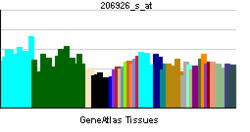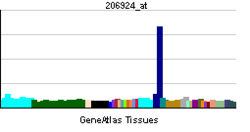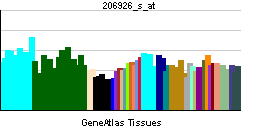Интерлеукин 11
From Wikipedia, the free encyclopedia
Интерлеукин 11 (ИЛ-11) је протеин који је код људи кодиран ИЛ11 геном.[1][2]
| Интерлеукин 11 | |||||||||||
|---|---|---|---|---|---|---|---|---|---|---|---|
| Идентификатори | |||||||||||
| Симболи | IL11; AGIF; IL-11 | ||||||||||
| Вањски ИД | OMIM: 147681 MGI: 107613 HomoloGene: 535 GeneCards: IL11 Gene | ||||||||||
| |||||||||||
| Преглед РНК изражавања | |||||||||||
 | |||||||||||
 | |||||||||||
| подаци | |||||||||||
| Ортолози | |||||||||||
| Врста | Човек | Миш | |||||||||
| Ентрез | 3589 | 16156 | |||||||||
| Eнсембл | ENSG00000095752 | ENSMUSG00000004371 | |||||||||
| UниПрот | P20809 | Q3V0U3 | |||||||||
| Реф. Секв. (иРНК) | NM_000641 | NM_008350 | |||||||||
| Реф. Секв. (протеин) | NP_000632 | NP_032376 | |||||||||
| Локација (УЦСЦ) |
Chr 19: 60.57 - 60.57 Mb |
Chr 7: 4.38 - 4.38 Mb | |||||||||
| ПубМед претрага | |||||||||||
ИЛ-11 је мултифункционални цитокин који је прво изолован 1990. године из кичмене мождине-изведених стромалних ћелија. Он је кључни регулатор of више евената хематопоезе, поготову стимулације сазревања мегакариоцита.[3] Он је исто познат под именима инхибиторни фактор адипогенезе (АГИФ)[4] и опрелвекин.
У поређењу са другим интерлеукинима, ИЛ-11 је релативно слабо карактерисан.
Структура
Људски ИЛ-11 ген, који садржи 5 ексона и 4 интрона, је лоциран на хромозому 19,[1] и кодира 23 протеин. ИЛ-11 is је члан ИЛ-6 цитокинске фамилије, која је особена по употреби заједничког корецептора гп130. Сигнал специфичност даје ИЛ-11Р алфа подјединица.
Сигнализација
Пренос сигнала се иницира након ИЛ-11 везивања за ИЛ-11Р алфа и гп130, што омогућава хомодимеризацију гп130 молекула. Ово омогућава гп130-асоцираној ЈАК кинази да се активира и да фосфорилише интрацелуларне тирозинове остатке на гп130.[5][6]
Функција
За ИЛ-11 је било показано да побољшава опоравак тромбоцита након хемотерапијом-узроковане тромбоцитопеније, индуцира акутну фазу протеина, модулира антиген-антитело одзив, учествује у регулацији пролиферације и диференцијације коштаних ћелија, и можда може бити коришћен као терапеутик за остеопорозу. ИЛ-11 стимулише раст одређених лимфоцита, и у моделу на глодарима, стимулише повећање кортикалне дебљине и јачање дугачких костију. Поред тога што има лимфопоетске/хематопоетске и остеотрофске особине, он функционише у многим другим ткивима, укључујући мозак, црева и тестисе.
Референце
Литература
Спољашње везе
Wikiwand - on
Seamless Wikipedia browsing. On steroids.
